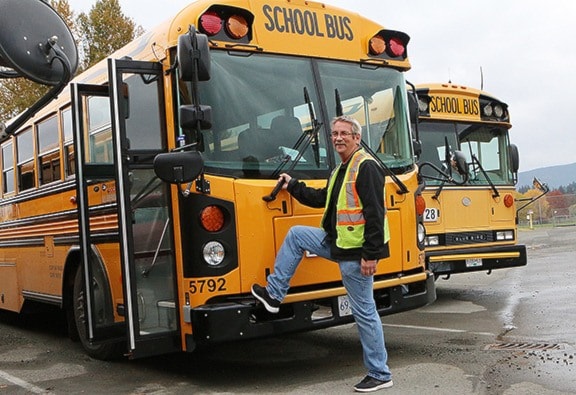When school bus fees went out the door, challenges may have slipped in to replace them, Cowichan Valley school trustees discovered last week.
Greater ridership could mean overflowing school buses.
One of the tasks the board of education has set themselves this fall is to review the district's transportation system: a big job that was put off during budget discussions in the spring simply because of its scope.
Monroe Grobe, operations manager for the Cowichan Valley school district, gave the first intimation of what trustees may have to wrestle with when he reported to the board Oct. 4 on how school bus use has increased since the province ordered the elimination of fees in August.
The reaction he's seen from parents and students to that ruling has been positive but it's time to take a look at where the district is as far as bus transportation, he said.
There are 31 buses on the road, carrying students throughout the district, with two older ones being replaced by new ones this month.
"Currently, this year, we have 3,142 students registered [to ride buses], which is up from 2,896 from last year and we expect that there are still some more to come in. Our projections are somewhere around the 3,300 to 3,400 student mark," Grobe said, calling this "a significant increase."
The sunny days of September meant that it's been hard to tell if the district will be able to actually carry everyone conveniently, he said.
"To this point, and this is a sort of weather-corrected type of a number, because of the fair weather, we haven't experienced any major overloads. We have some buses that are very full. But as we head into the more inclement weather we are expecting some possible overloads on those buses, primarily at the secondary level," Grobe said.
"We can only sit 56 students per bus on those buses so that does create some pressure."
So far, transportation supervisor Tom Clark and his staff have been making adjustments on the fly, re-routing some buses as needed.
"Although we are running efficiently right now we are preparing for a little bit of an increase, a little more pressure on those routes," Grobe said, going on to point out one area trustees might want to examine more closely.
"The largest increase in ridership is for those secondary students that are riding within catchment area walk limits so that may be something as we embark on the transportation review that might be one of the first areas we will seriously have to look at if push comes to shove."
Trustee Cathy Schmidt, one of those who pushed for the transportation review, asked if, with the numbers up this year compared to last year, the district had to add buses and would a final increase to 3,300 or 3,400 riders push the district over the top.
Grobe replied, "No. It's been an increase that has just filled up the buses to this point. There is still a little bit of room. How we work it is that we relieve a little bit of pressure on this bus by re-routing another to enter into an area. That is how we try to accommodate it.
"And, with these new buses coming in, we'll create two more spare buses that we can use in our fleet if we do have those pressures."
However, acquiring new buses takes time because approvals are needed at ministry level, he said.
That means there are some challenges coming to ensure students get in and out of school in an appropriate manner.
"We're really at capacity to accommodate what we have just now. But there are some areas that we go into where we just can't send another bus in to pick those [riders] up. We're trying very hard to get the students to school on time within a certain window so we're not facing challenges with supervision at the school level," Grobe said.
